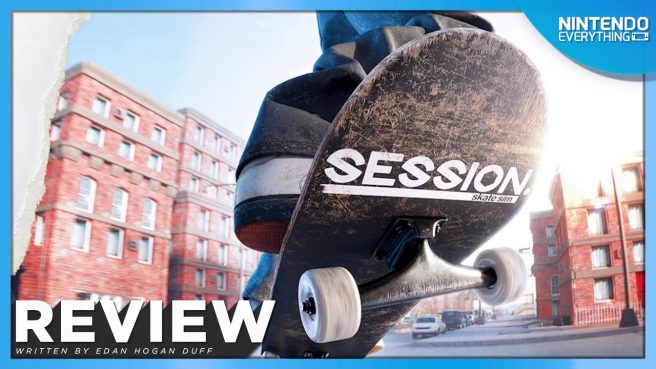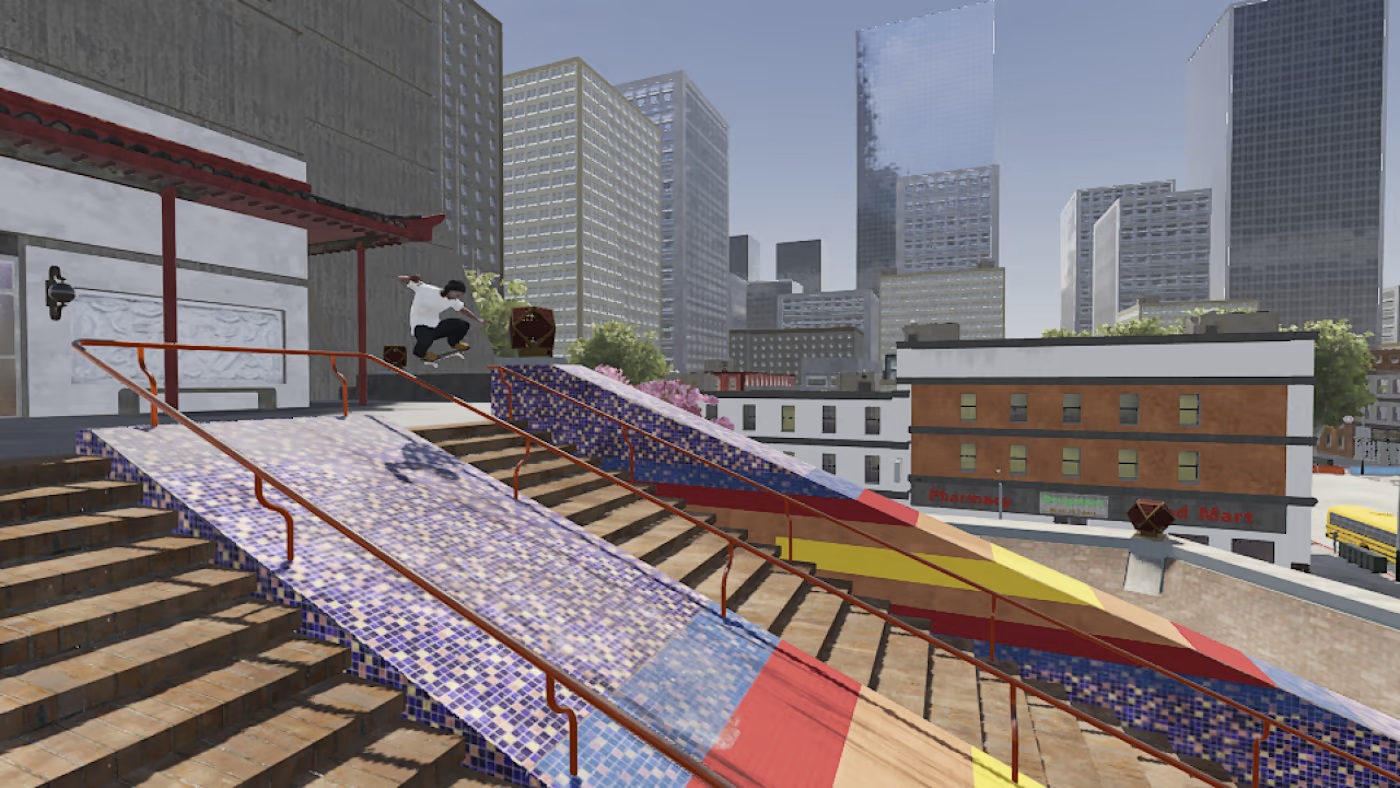System: Switch
Release date: March 9, 2023
Developer: Crea-ture Studios
Publisher: Nacon
For a lapsed real-world skateboarder like myself, Session: Skate Sim is a sobering reality check. Back in 2020, Activision’s Tony Hawk’s remake momentarily convinced me that I had the skills to recommit to the sport – that within a few weeks I’d be busting out Tre Flips with the best of them. If only I had been given access to Session: Skate Sim back then, so that I could be brought back down to earth and reminded of just how achingly difficult skateboarding really is. Upon casting your eye over Session for the first time, you may be fooled into thinking that it follows in the footsteps of EA’s Skate franchise. In reality this game is to Skate what actually going outside and skateboarding is to sitting on the couch and thinking about it. It’s incredibly hard. Session: Skate Sim comes to us Switch owners at the end of a long Early Access run on other platforms. Following years of iterative patches and improvements, the game has now reached its version 1.0 milestone. Unfortunately, the game we’ve been landed with feels anything but finished.
It’s dizzying trying to establish just where to begin with Session. To its credit, the game features a lot of content. There is more to explore out of the box in Session than in any other indie skateboarding title currently doing the rounds. It’s this wealth of content however that almost immediately gives the impression that Session has spread itself too thin. In pushing for that coveted 1.0 “this game is finished” milestone, the core skating experience in Session feels a touch neglected. There are a large number of maps based on US cities, along with a veritable treasure trove of decks, trucks, and clothing options for you to adorn your created skater in the latest threads. There are a variety of missions to complete, an incredibly lengthy tutorial dealing with all of the basics of skating, and an advanced options menu that puts some flight simulators to shame in how it allows you to tweak the experience. In light of how underdeveloped the core skateboarding experience feels however, all of these trimmings feel somewhat superfluous.
As previously mentioned, Session shares a portion of its DNA with EA’s Skate franchise – especially when it comes to its presentation. Despite the initial similarities, Session is far more comprehensive in how it offers you up control of your skater. During most situations you turn your virtual dude (or dudette) with either ZL/ZR or the left analog stick. Pulling off tricks is done by flicking both the left and right analog sticks in various directions to mimic the actions of your front and back foot, respectively. To kickflip for instance, you pull the right stick down and flick it straight up, while simultaneously flicking the left analog stick in a north-easterly direction. On paper it sounds relatively intuitive, but in motion? It feels awful.
To be completely frank, I’m not entirely sure where Session’s issues end and the Switch’s begin in this case – in fact, I have little confidence that the game is a great fit for the Switch, owing to the complexity of its control scheme and the quality of the port. Whereas on other machines you have access to full size analog sticks as standard, on Switch you’re likely using a Joy-Con with its deadzone-laden mini-nubs. Countless times I was scuppered by these factors as I intended to do a specific trick but inadvertently ended up doing something else, or simply falling over. Sometimes this disconnect yielded some cool looking accidents – however I became partially reliant on this happening in order to make anything exciting occur on screen, which isn’t ideal.
Compounding these control issues is the game’s woeful image quality (and sometimes performance) on Switch. I say sometimes, as I allude to the game’s aforementioned options menu as the cause of an optionally terrible frame rate – I know this sounds odd, but bear with me. As I explored Session’s encyclopedic configuration menu, I came upon a toggle to add physics to my player character’s animation – cool, I thought, I’ll try it out. This option honestly improved the game’s feel by what felt like a tangible margin, however it also lowered the framerate noticeably. Additionally, I found a “turn on NPCs” option, which transformed my game into a collection of pictures resembling skateboarding – honestly, the game must have been running at 10 FPS. By attempting to add a bit of life to proceedings, I essentially broke it.
Switching those options off I returned the game to its default state, where I was left with what I would earnestly consider to be one of the worst looking 3D games I’ve seen running on the platform. The resolution is painfully low – especially in handheld – to the point where lining up tricks with the environment is relentlessly fiddly as a result. It also looks, well, ugly – with a “lower than low” graphics configuration seemingly in place across the board (get it?). NPCs and environments look ghastly, adopting an “iPhone game from 2009” aesthetic which isn’t as charming as it sounds. Normally I’d let issues like these speak for themselves when reviewing a Switch title, as your sensitivity to them may differ to mine. In this instance however, the game feels utterly compromised by them at a fundamental level.
It’s an honest shame too, as developer Crea-ture is clearly in love with the sport. There is no shortage of affection for skating culture to be found in Session, it’s just that its vast multitude of systems and options don’t gel together into a cohesive experience. It’s stuck somewhere between being a utilitarian tool for tweaking options and building out reels using its impressive replay editor, and offering up a traditional, campaign-led skateboarding game that could potentially appeal to more casual gamers. Whilst seemingly aiming for both of these things, it has unfortunately achieved neither. For all the game offers, there are some curious omissions too – there are no grab tricks, for instance, which feels like a bit of a cardinal sin for a game that labels itself as a “Skate Sim”. Lip tricks are treated as an experimental feature too, but I found no way of doing them in-game. Session isn’t lacking in ambition, but it’s definitely missing a trick.
The Verdict

As a lover of all things skating, it’s disheartening to see Session: Skate Sim arrive on Switch in such a compromised state. While I’m glad that the excellent Tony Hawk’s 1+2 remake exists on Switch to satiate our skating desires, I was really rooting for Session as soon as I saw it appear on the release calendar. In isolation, any of the issues I’ve mentioned in this review would be enough to significantly hamper any enjoyment you could glean from the game – stacked upon one another it’s a whole different story. Between the technical performance, the stodgy controls, the lackluster visual presentation, and the somewhat directionless yet invasive campaign content, it would be best to wait until the game either receives a substantial set of patches, or drops down in price to a level where you can live with the subpar quality – treating it instead as a skate-oddity.
Session: Skate Sim copy provided by the publisher for the purposes of this review.


